Embedded Brain Computer Interface: State-of-the-Art in Research
Abstract
:1. Introduction
2. Review of the Embedded BCI Systems
2.1. Review of the Acquisition Systems
2.2. Embedded BCI Systems for Pathological Disorders
2.3. Embedded BCI Systems for Functional Substitution
2.4. Review of the Embedded Architecture of BCI
2.4.1. EBCI Based on Software Architecture
2.4.2. EBCI Based on Hardware Architecture
2.4.3. EBCI Based on Hardware/Software Architecture
3. Challenges and Future Research Directions for EBCI Systems
- Inaccuracy of the BCI in terms of prediction or classifying brain signals.
- The artifacts and outliers that can limit its usability and the interpretability of the extracted features which can be noise-affected due to the low signal-to-noise ratio characterizing the EEG signals.
- Limited ability to read brain signals for those BCIs placed outside the skull.
- Number of ethical issues due to reading people’s inner thoughts [83].
- The security of personal data not being guaranteed against attackers or intruders [83].
- In some cases, requirement for drastic surgery.
3.1. Pure Software Architecture
3.2. Hardware/Software Architecture
3.3. Pure Hardware Architecture
3.4. Evaluation Criteria of the Future EBCI Systems
4. Conclusions
Author Contributions
Funding
Institutional Review Board Statement
Informed Consent Statement
Data Availability Statement
Conflicts of Interest
References
- Subramanian, R.R.; Varma, K.Y.; Balaji, K.; Reddy, M.D.; Akash, A.; Reddy, K.N. Multiplayer Online Car Racing with BCI In VR. In Proceedings of the 2021 5th International Conference on Intelligent Computing and Control Systems (ICICCS), Madurai, India, 6–8 May 2021. [Google Scholar] [CrossRef]
- Wang, L.; Ding, X.; Zhang, W.; Yang, S. Differences in EEG Microstate Induced by Gaming: A Comparison between the Gaming Disorder Individual, Recreational Game Users and Healthy Controls. IEEE Access 2021, 9, 32549–32558. [Google Scholar] [CrossRef]
- Holzner, C.; Guger, C.; Edlinger, G.; Gronegress, C.; Slater, M. Virtual Smart Home Controlled by Thoughts. In Proceedings of the 2009 18th IEEE International Workshops on Enabling Technologies: Infrastructures for Collaborative Enterprises, Groningen, The Netherlands, 7 July 2009. [Google Scholar] [CrossRef]
- Kim, J.W.; Kim, M.N.; Kang, D.H.; Ahn, M.H.; Kim, H.S.; Min, B.K. An online top-down SSVEP-BMI for augmented reality. In Proceedings of the 2019 7th International Winter Conference on Brain-Computer Interface (BCI), Gangwon, Korea, 17 June 2019. [Google Scholar] [CrossRef]
- Wolf, D.; Wagner, T.; Rukzio, E. Low-Cost Real-Time Mental Load Adaptation for Augmented Reality Instructions—A Feasibility Study. In Proceedings of the 2019 IEEE International Symposium on Mixed and Augmented Reality Adjunct (ISMAR-Adjunct), Beijing, China, 9 January 2020. [Google Scholar] [CrossRef]
- Gonzalez, E.J.S.; McMullen, K. The Design of an Algorithmic Modal Music Platform for Eliciting and Detecting Emotion. In Proceedings of the 2020 8th International Winter Conference on Brain-Computer Interface (BCI), Gangwon, Korea, 9 April 2020. [Google Scholar] [CrossRef]
- Bai, L.; Yu, T.; Li, Y. Explorer based on brain computer interface. In Proceedings of the 2014 International Joint Conference on Neural Networks (IJCNN), Beijing, China, 4 September 2014. [Google Scholar] [CrossRef]
- Spuler, M. A Brain-Computer Interface (BCI) system to use arbitrary Windows applications by directly controlling mouse and keyboard. In Proceedings of the 2015 37th Annual International Conference of the IEEE Engineering in Medicine and Biology Society (EMBC), Milan, Italy, 5 November 2015. [Google Scholar] [CrossRef]
- Belwafi, K.; Gannouni, S.; Aboalsamh, H. An Effective Zeros-Time Windowing Strategy to Detect Sensorimotor Rhythms Related to Motor Imagery EEG Signals. IEEE Access 2020, 8, 152669–152679. [Google Scholar] [CrossRef]
- Bonci, A.; Fiori, S.; Higashi, H.; Tanaka, T.; Verdini, F. An Introductory Tutorial on Brain–Computer Interfaces and Their Applications. Electronics 2021, 10, 560. [Google Scholar] [CrossRef]
- Chaudhary, U.; Birbaumer, N.; Ramos-Murguialday, A. Brain–computer interfaces for communication and rehabilitation. Nat. Rev. Neurol. 2016, 12, 513–525. [Google Scholar] [CrossRef] [Green Version]
- Lebedev, M.A.; Nicolelis, M.A. Brain–machine interfaces: Past, present and future. Trends Neurosci. 2006, 29, 536–546. [Google Scholar] [CrossRef] [PubMed]
- Lin, C.T.; Chen, Y.C.; Huang, T.Y.; Chiu, T.T.; Ko, L.W.; Liang, S.F.; Hsieh, H.Y.; Hsu, S.H.; Duann, J.R. Development of wireless brain computer interface with embedded multitask scheduling and its application on real-time driver’s drowsiness detection and warning. IEEE Trans. Biomed. Eng. 2008, 55, 1582–1591. [Google Scholar] [CrossRef] [PubMed]
- Jiang, L.; Tham, E.; Yeo, M.; Phu, O.G. iPhone-based portable brain control wheelchair. In Proceedings of the 2012 7th IEEE Conference on Industrial Electronics and Applications (ICIEA), Singapore, 26 November 2012. [Google Scholar] [CrossRef]
- Wijesinghe, L.; Wickramasuriya, D.; Pasqual, A.A. A generalized preprocessing and feature extraction platform for scalp EEG signals on FPGA. In Proceedings of the 2014 IEEE Conference on Biomedical Engineering and Sciences (IECBES), Kuala Lumpur, Malaysia, 26 February 2015. [Google Scholar] [CrossRef]
- Lee, S.; Shin, Y.; Woo, S.; Kim, K.; Lee, H.N. Review of wireless brain-computer interface systems. In Brain-Computer Interface Systems-Recent Progress and Future Prospects; InTech: London, UK, 2013. [Google Scholar]
- Lotte, F.; Bougrain, L.; Cichocki, A.; Clerc, M.; Congedo, M.; Rakotomamonjy, A.; Yger, F. A review of classification algorithms for EEG-based brain–computer interfaces: A 10 year update. J. Neural Eng. 2018, 15, 031005. [Google Scholar] [CrossRef] [Green Version]
- Prashant, P.; Joshi, A.; Gandhi, V. Brain computer interface: A review. In Proceedings of the 2015 5th Nirma University International Conference on Engineering (NUiCONE), Ahmedabad, India, 11 April 2016. [Google Scholar] [CrossRef]
- Marshall, D.; Coyle, D.; Wilson, S.; Callaghan, M. Games, Gameplay, and BCI: The State of the Art. IEEE Trans. Comput. Intell. AI Games 2013, 5, 82–99. [Google Scholar] [CrossRef]
- Nicolas-Alonso, L.F.; Gomez-Gil, J. Brain Computer Interfaces, a Review. Sensors 2012, 12, 1211–1279. [Google Scholar] [CrossRef] [PubMed]
- Kawala-Sterniuk, A.; Browarska, N.; Al-Bakri, A.; Pelc, M.; Zygarlicki, J.; Sidikova, M.; Martinek, R.; Gorzelanczyk, E.J. Summary of over Fifty Years with Brain-Computer Interfaces—A Review. Brain Sci. 2021, 11, 43. [Google Scholar] [CrossRef]
- Chai, R.; Naik, G.R.; Ling, S.H.; Nguyen, H.T. Hybrid brain–computer interface for biomedical cyber-physical system application using wireless embedded EEG systems. Biomed. Eng. Online 2017, 16, 5. [Google Scholar] [CrossRef] [Green Version]
- Belwafi, K.; Ghaffari, F.; Djemal, R.; Romain, O. A Hardware/Software Prototype of EEG-based BCI System for Home Device Control. J. Signal Process. Syst. 2017, 89, 263–279. [Google Scholar] [CrossRef]
- Chabuda, A.; Durka, P.; Zygierewicz, J. High Frequency SSVEP-BCI with Hardware Stimuli Control and Phase-Synchronized Comb Filter. IEEE Trans. Neural Syst. Rehabil. Eng. 2018, 26, 344–352. [Google Scholar] [CrossRef]
- Schomer, D.L.; Da Silva, F.L. Niedermeyer’s Electroencephalography: Basic Principles, Clinical Applications, and Related Fields; Lippincott Williams & Wilkins: Philadelphia, PA, USA, 2012. [Google Scholar]
- Ahmed, M.A.; Qi, D.; Alshemmary, E.N. Effective Hybrid Method for the Detection and Rejection of Electrooculogram (EOG) and Power Line Noise Artefacts From Electroencephalogram (EEG) Mixtures. IEEE Access 2020, 8, 202919–202932. [Google Scholar] [CrossRef]
- Jrad, N.; Kachenoura, A.; Merlet, I.; Bartolomei, F.; Nica, A.; Biraben, A.; Wendling, F. Automatic Detection and Classification of High-Frequency Oscillations in Depth-EEG Signals. IEEE Trans. Biomed. Eng. 2017, 64, 2230–2240. [Google Scholar] [CrossRef] [PubMed]
- Sudha, N.S.; Dodda, R.K. Design of error normalized LMS adaptive filter for EEG signal with eye blink & PLI artefacts. In Proceedings of the 2017 International Conference on Trends in Electronics and Informatics (ICEI), Tirunelveli, India, 11–12 May 2017. [Google Scholar] [CrossRef]
- Ogawa, T.; Hirayama, J.-I.; Gupta, P.; Moriya, H.; Yamaguchi, S.; Ishikawa, A.; Inoue, Y.; Kawanabe, M.; Ishii, S. Brain-machine interfaces for assistive smart homes: A feasibility study with wearable near-infrared spectroscopy. In Proceedings of the 2015 37th Annual International Conference of the IEEE Engineering in Medicine and Biology Society (EMBC), Milan, Italy, 11–12 May 2015. [Google Scholar] [CrossRef]
- Correa, M.A.G.; Laciar, E. Noise Removal from EEG Signals in Polisomnographic Records Applying Adaptive Filters in Cascade. In Adaptive Filtering Applications; InTech: London, UK, 2011. [Google Scholar] [CrossRef] [Green Version]
- Lotte, F.; Congedo, M.; Lécuyer, A.; Lamarche, F.; Arnaldi, B. A review of classification algorithms for EEG-based brain-computer interfaces. J. Neural Eng. 2007, 4, R1. [Google Scholar] [CrossRef] [PubMed]
- Kübler, A.; Neumann, N.; Kaiser, J.; Kotchoubey, B.; Hinterberger, T.; Birbaumer, N.P. Brain-computer communication: Self-regulation of slow cortical potentials for verbal communication. Arch. Phys. Med. Rehabil. 2001, 82, 1533–1539. [Google Scholar] [CrossRef]
- Piccini, L.; Parini, S.; Maggi, L.; Andreoni, G. A Wearable Home BCI system: Preliminary results with SSVEP protocol. In Proceedings of the 2005 IEEE Engineering in Medicine and Biology 27th Annual Conference, Shanghai, China, 10 April 2006. [Google Scholar] [CrossRef]
- Corralejo, R.; Álvarez, D.; Hornero, R. A P300-Based BCI Aimed at Managing Electronic Devices for People with Severe Disabilities. In Converging Clinical and Engineering Research on Neurorehabilitation; Springer: Berlin/Heidelberg, Germany, 2013; pp. 641–645. [Google Scholar] [CrossRef]
- Kwon, O.Y.; Lee, M.H.; Guan, C.; Lee, S.W. Subject-Independent Brain–Computer Interfaces Based on Deep Convolutional Neural Networks. IEEE Trans. Neural Netw. Learn. Syst. 2020, 31, 3839–3852. [Google Scholar] [CrossRef]
- Do, A.H.; Wang, P.T.; King, C.E.; Schombs, A.; Cramer, S.C.; Nenadic, Z. Brain-computer interface controlled functional electrical stimulation device for foot drop due to stroke. In Proceedings of the 2012 Annual International Conference of the IEEE Engineering in Medicine and Biology Society, San Diego, CA, USA, 12 November 2012. [Google Scholar] [CrossRef] [Green Version]
- Zander, T.O.; Kothe, C.; Jatzev, S.; Gaertner, M. Enhancing Human-Computer Interaction with Input from Active and Passive Brain-Computer Interfaces. In Brain-Computer Interfaces; Springer: London, UK, 2010; pp. 181–199. [Google Scholar] [CrossRef]
- Jafari, R.; Dehzangi, O.; Zong, C.; Nathan, V. BCIBench. In Proceedings of the 11th Workshop on Optimizations for DSP and Embedded Systems, ODES’14, Orlando, FL, USA, 15 February 2014. [Google Scholar] [CrossRef]
- Tamilarasi, S.; Sundararajan, J. FPGA based seizure detection and control for brain computer interface. Clust. Comput. 2018, 22, 11841–11848. [Google Scholar] [CrossRef]
- Aravind, M.; Babu, S.S. Embedded implementation of brain computer interface using FPGA. In Proceedings of the Emerging Technological Trends (ICETT), International Conference on IEEE, Kollam, India, 21–22 October 2016; pp. 1–5. [Google Scholar] [CrossRef]
- Kartsch, V.; Benatti, S.; Rossi, D.; Benini, L. A wearable EEG-based drowsiness detection system with blink duration and alpha waves analysis. In Proceedings of the 2017 8th International IEEE/EMBS Conference on Neural Engineering (NER), Shanghai, China, 15 August 2017. [Google Scholar] [CrossRef] [Green Version]
- Li, G.; Chung, W.Y. Combined EEG-Gyroscope-tDCS Brain Machine Interface System for Early Management of Driver Drowsiness. IEEE Trans. Hum. Mach. Syst. 2018, 48, 50–62. [Google Scholar] [CrossRef]
- Sawan, M.; Salam, M.T.; Lan, J.L.; Kassab, A.; Gelinas, S.; Vannasing, P.; Lesage, F.; Lassonde, M.; Nguyen, D.K. Wireless Recording Systems: From Noninvasive EEG-NIRS to Invasive EEG Devices. IEEE Trans. Biomed. Circuits Syst. 2013, 7, 186–195. [Google Scholar] [CrossRef]
- Roh, T.; Song, K.; Cho, H.; Shin, D.; Yoo, H.J. A Wearable Neuro-Feedback System with EEG-Based Mental Status Monitoring and Transcranial Electrical Stimulation. IEEE Trans. Biomed. Circuits Syst. 2014, 8, 755–764. [Google Scholar] [CrossRef] [PubMed]
- Verma, N.; Shoeb, A.; Bohorquez, J.; Dawson, J.; Guttag, J.; Chandrakasan, A.P. A Micro-Power EEG Acquisition SoC with Integrated Feature Extraction Processor for a Chronic Seizure Detection System. IEEE J. Solid State Circuits 2010, 45, 804–816. [Google Scholar] [CrossRef]
- Heelan, C.; Nurmikko, A.; Truccolo, W. FPGA implementation of deep-learning recurrent neural networks with sub-millisecond real-time latency for BCI-decoding of large-scale neural sensors (104 nodes). In Proceedings of the 2018 40th Annual International Conference of the IEEE Engineering in Medicine and Biology Society (EMBC), Honolulu, HI, USA, 29 October 2018. [Google Scholar] [CrossRef]
- Ma, X.; Zheng, W.; Peng, Z.; Yang, J. FPGA-Based Rapid Electroencephalography Signal Classification System. In Proceedings of the 2019 IEEE 11th International Conference on Advanced Infocomm Technology (ICAIT), Jinan, China, 19 December 2019. [Google Scholar] [CrossRef]
- Shyu, K.K.; Lee, P.L.; Lee, M.H.; Lin, M.H.; Lai, R.J.; Chiu, Y.J. Development of a Low-Cost FPGA-Based SSVEP BCI Multimedia Control System. Biomed. Circuits Syst. IEEE Trans. 2010, 4, 125–132. [Google Scholar] [CrossRef]
- Palumbo, A.; Amato, F.; Calabrese, B.; Cannataro, M.; Cocorullo, G.; Gambardella, A.; Guzzi, P.H.; Lanuzza, M.; Sturniolo, M.; Veltri, P.; et al. An Embedded System for EEG Acquisition and Processing for Brain Computer Interface Applications. In Wearable and Autonomous Biomedical Devices and Systems for Smart Environment; Springer: Berlin/Heidelberg, Germany, 2010; pp. 137–154. [Google Scholar] [CrossRef]
- Hassan, M.; Islam, S.M.R. Design and Implementation of Pre-processing Chip for Brain Computer Interface Machine. In Proceedings of the 2019 International Conference on Robotics, Electrical and Signal Processing Techniques (ICREST), Dhaka, Bangladesh, 21 February 2019. [Google Scholar] [CrossRef]
- Tseng, K.C.; Lin, B.S.; Wong, A.M.K.; Lin, B.S. Design of a mobile brain computer interface-based smart multimedia controller. Sensors 2015, 15, 5518–5530. [Google Scholar] [CrossRef] [PubMed] [Green Version]
- Lin, C.T.F. EEG-based Brain-computer Interface for Smart Living Environment Auto-adjustment. J. Med. Biol. Eng. 2010, 30, 237. [Google Scholar] [CrossRef]
- García, P.A.; Spinelli, E.M.; Toccaceli, G.M. An Embedded Hybrid BCI Speller. In Proceedings of the VII Latin American Congress on Biomedical Engineering CLAIB 2016, Bucaramanga, Santander, Colombia, 26–28 October 2016; Springer: Singapore, 2017; pp. 26–29. [Google Scholar] [CrossRef]
- Jafari, R.; Dehzangi, O.; Zong, C.; Nathan, V. Implementation of a Wheelchair Control Using a Four-Command Brain Computer Interface. In Proceedings of the 22nd International Congress of Mechanical Engineering (COBEM), São Paulo, Brazil, 3–7 November 2013. [Google Scholar]
- Condori, K.A.; Urquizo, E.C.; Diaz, D.A. Embedded Brain Machine Interface based on motor imagery paradigm to control prosthetic hand. In Proceedings of the ANDESCON, 2016 IEEE, Arequipa, Peru, 2 February 2017; pp. 1–4. [Google Scholar]
- McCrimmon, C.M.; Fu, J.L.; Wang, M.; Lopes, L.S.; Wang, P.T.; Karimi-Bidhendi, A.; Liu, C.Y.; Heydari, P.; Nenadic, Z.; Do, A.H. Performance Assessment of a Custom, Portable, and Low-Cost Brain–Computer Interface Platform. IEEE Trans. Biomed. Eng. 2017, 64, 2313–2320. [Google Scholar] [CrossRef] [PubMed] [Green Version]
- García, P.A.; Spinelli, E.M.; Toccaceli, G.M. An embedded system for evoked biopotential acquisition and processing. Int. J. Embed. Syst. 2014, 6, 86. [Google Scholar] [CrossRef]
- Wöhrle, H.; Tabie, M.; Kim, S.; Kirchner, F.; Kirchner, E. A Hybrid FPGA-Based System for EEG- and EMG-Based Online Movement Prediction. Sensors 2017, 17, 1552. [Google Scholar] [CrossRef] [Green Version]
- Lin, C.T.; Lin, B.S.; Lin, F.C.; Chang, C.J. Brain Computer Interface-Based Smart Living Environmental Auto-Adjustment Control System in UPnP Home Networking. IEEE Syst. J. 2014, 8, 363–370. [Google Scholar] [CrossRef] [Green Version]
- Lin, J.S.; Hsieh, C.H. A BCI Control System for TV Channels Selection. Int. J. Commun. 2014, 3, 1–5. [Google Scholar]
- Ou, C.Z.; Lin, B.S.; Chang, C.J.; Lin, C.T. Brain Computer Interface-based Smart Environmental Control System. In Proceedings of the 2012 Eighth International Conference on Intelligent Information Hiding and Multimedia Signal Processing, Piraeus-Athens, Greece, 23 August 2012. [Google Scholar] [CrossRef]
- Qassim, Y.T.; Cutmore, T.; James, D.; Rowlands, D. FPGA implementation of Morlet continuous wavelet transform for EEG analysis. In Proceedings of the 2012 International Conference on Computer and Communication Engineering (ICCCE), Kuala Lumpur, Malaysia, 20 August 2012. [Google Scholar] [CrossRef]
- Patki, S.; Grundlehner, B.; Nakada, T.; Penders, J. Low Power Wireless EEG Headset for BCI Applications. In Lecture Notes in Computer Science; Springer: Berlin/Heidelberg, Germany, 2011; pp. 481–490. [Google Scholar] [CrossRef]
- Belwafi, K.; Romain, O.; Gannouni, S.; Ghaffari, F.; Djemal, R.; Ouni, B. An embedded implementation based on adaptive filter bank for brain–computer interface systems. J. Neurosci. Methods 2018, 305, 1–16. [Google Scholar] [CrossRef]
- Khurana, K.; Gupta, P.; Panicker, R.C.; Kumar, A. Development of an FPGA-based real-time P300 speller. In Proceedings of the 22nd International Conference on Field Programmable Logic and Applications (FPL), Oslo, Norway, 25 October 2012. [Google Scholar] [CrossRef]
- Št’astný, J. A modular hardware platform for brain-computer interface. In Proceedings of the 2012 International Conference on Applied Electronics, Pilsen, Czech Republic, 5–7 September 2012; pp. 287–290. [Google Scholar]
- Khattak, F.A.; Saif, U.; Zahid, A.B.; Nazir, M.S.; Aqil, M. Brain activity monitoring system with HDMI interface developed on an FPGA. In Proceedings of the 2016 International Conference on Emerging Technologies (ICET), Islamabad, Pakistan, 16 January 2017. [Google Scholar] [CrossRef]
- Zhang, Y.; Xie, J.; Xu, G.; Fang, P.; Cui, G.; Li, G.; Cao, G.; Xue, T.; Zhang, X.; Li, M.; et al. FPGA Implementation of Visual Noise Optimized Online Steady-State Motion Visual Evoked Potential BCI System. In Proceedings of the 2020 17th International Conference on Ubiquitous Robots (UR), Kyoto, Japan, 21 July 2020. [Google Scholar] [CrossRef]
- KalyanaSundaram, C.; Marichamy, P.; Devu, R.R. Feature extraction for the patient consciousness detection using P300 event. In Proceedings of the 2017 4th International Conference on Advanced Computing and Communication Systems (ICACCS), Coimbatore, India, 24 August 2017. [Google Scholar] [CrossRef]
- Feng, C.W.; Chang, J.C.; Chen, W.C.; Fang, W.C. A reliable brain computer interface implemented on FPGA for mobile dialing system. In Proceedings of the 2015 IEEE International Conference on Consumer Electronics-Taiwan, Taipei, Taiwan, 24 August 2015. [Google Scholar] [CrossRef]
- Chou, C.C.; Chen, T.Y.; Fang, W.C. FPGA implementation of EEG system-on-chip with automatic artifacts removal based on BSS-CCA method. In Proceedings of the 2016 IEEE Biomedical Circuits and Systems Conference (BioCAS), Shanghai, China, 26 January 2017. [Google Scholar] [CrossRef]
- Shrivastwa, R.R.; Pudi, V.; Chattopadhyay, A. An FPGA-Based Brain Computer Interfacing Using Compressive Sensing and Machine Learning. In Proceedings of the 2018 IEEE Computer Society Annual Symposium on VLSI (ISVLSI), Hong Kong, China, 9 August 2018. [Google Scholar] [CrossRef]
- Lin, J.S.; Hsieh, C.H. A Wireless BCI-Controlled Integration System in Smart Living Space for Patients. Wirel. Pers. Commun. 2015, 88, 395–412. [Google Scholar] [CrossRef]
- Malekmohammadi, A.; Mohammadzade, H.; Chamanzar, A.; Shabany, M.; Ghojogh, B. An Efficient Hardware Implementation for a Motor Imagery Brain Computer Interface System. Sci. Iran. 2018, 72–94. [Google Scholar] [CrossRef] [Green Version]
- Feng, Z.; Zeng, L.; Wu, H.; Tian, F.; He, Q. Design of an Online Brain-Computer Interface System Based on Field Programmable Gate Array. J. Phys. Conf. Ser. 2020, 1624, 042061. [Google Scholar] [CrossRef]
- Luis, C.; Marcos Rojas, C.; David, J.; Chailloux Peguero, J.; Blanco, A. Real time identification of motor imagery actions on EEG signals. Ing. Electron. Autom. Comun. 2020, 41, 101–117. [Google Scholar]
- Shyu, K.K.; Chiu, Y.J.; Lee, P.L.; Lee, M.H.; Sie, J.J.; Wu, C.H.; Wu, Y.T.; Tung, P.C. Total Design of an FPGA-Based Brain–Computer Interface Control Hospital Bed Nursing System. IEEE Trans. Ind. Electron. 2013, 60, 2731–2739. [Google Scholar] [CrossRef]
- Karkon, R.; Shahshahani, S.M.R.; Mahdiani, H.R. A Custom Hardware CCA Engine for Real-time SSVEP-based BCI Applications. In Proceedings of the 2020 20th International Symposium on Computer Architecture and Digital Systems (CADS), Rasht, Iran, 5 October 2020. [Google Scholar] [CrossRef]
- Byun, W.; Kim, D.; Kim, S.Y.; Kim, J.H. A 110.3-bits/min 8-Ch SSVEP-based Brain-Computer Interface SoC with 87.9% Accuracy. In Proceedings of the 2019 IEEE Asian Solid-State Circuits Conference (A-SSCC), Macao, 6 April 2020. [Google Scholar] [CrossRef]
- Lou, Q.; Liu, W.; Liu, W.; Guo, F.; Jiang, L. MindReading: An Ultra-Low-Power Photonic Accelerator for EEG-based Human Intention Recognition. In Proceedings of the 2020 25th Asia and South Pacific Design Automation Conference (ASP-DAC), Beijing, China, 26 March 2020. [Google Scholar] [CrossRef] [Green Version]
- Ramírez-Quintana, J.; Macias-Macias, J.; Corral-Saenz, A.; Chacon-Murguia, M. Novel SSVEP Processing Method Based on Correlation and Feedforward Neural Network for Embedded Brain Computer Interface. In Lecture Notes in Computer Science; Springer International Publishing: Berlin, Germany, 2019; pp. 248–258. [Google Scholar] [CrossRef]
- Brill, F.; Erukhimov, V.; Giduthuri, R.; Ramm, S. Chapter 10-Neural networks. In OpenVX Programming Guide; Brill, F., Erukhimov, V., Giduthuri, R., Ramm, S., Eds.; Academic Press: Cambridge, MA, USA, 2020; pp. 205–214. [Google Scholar] [CrossRef]
- Bernal, S.L.; Celdrán, A.H.; Pérez, G.M.; Barros, M.T.; Balasubramaniam, S. Security in Brain-Computer Interfaces. ACM Comput. Surv. 2021, 54, 1–35. [Google Scholar] [CrossRef]
- Solms, F. What is software architecture? In Proceedings of the South African Institute for Computer Scientists and Information Technologists Conference (SAICSIT’12), Pretoria, South Africa, 1–3 October 2012. [Google Scholar] [CrossRef]
- Teams, X. Vitis AI User Guide, UG1414 (v1.3); Xilinx: San Jose, CA, USA, 2021; p. 132. [Google Scholar]
- Dutta, P.; Upendra, G.; Giribabu, E.; Tyagi, V. Article: A Comprehensive Review of Embedded System Design Aspects for Rural Application Platform. Int. J. Comput. Appl. 2014, 106, 39–44. [Google Scholar]
- Speier, W.; Arnold, C.; Pouratian, N. Evaluating True BCI Communication Rate through Mutual Information and Language Models. PLoS ONE 2013, 8, e78432. [Google Scholar] [CrossRef]
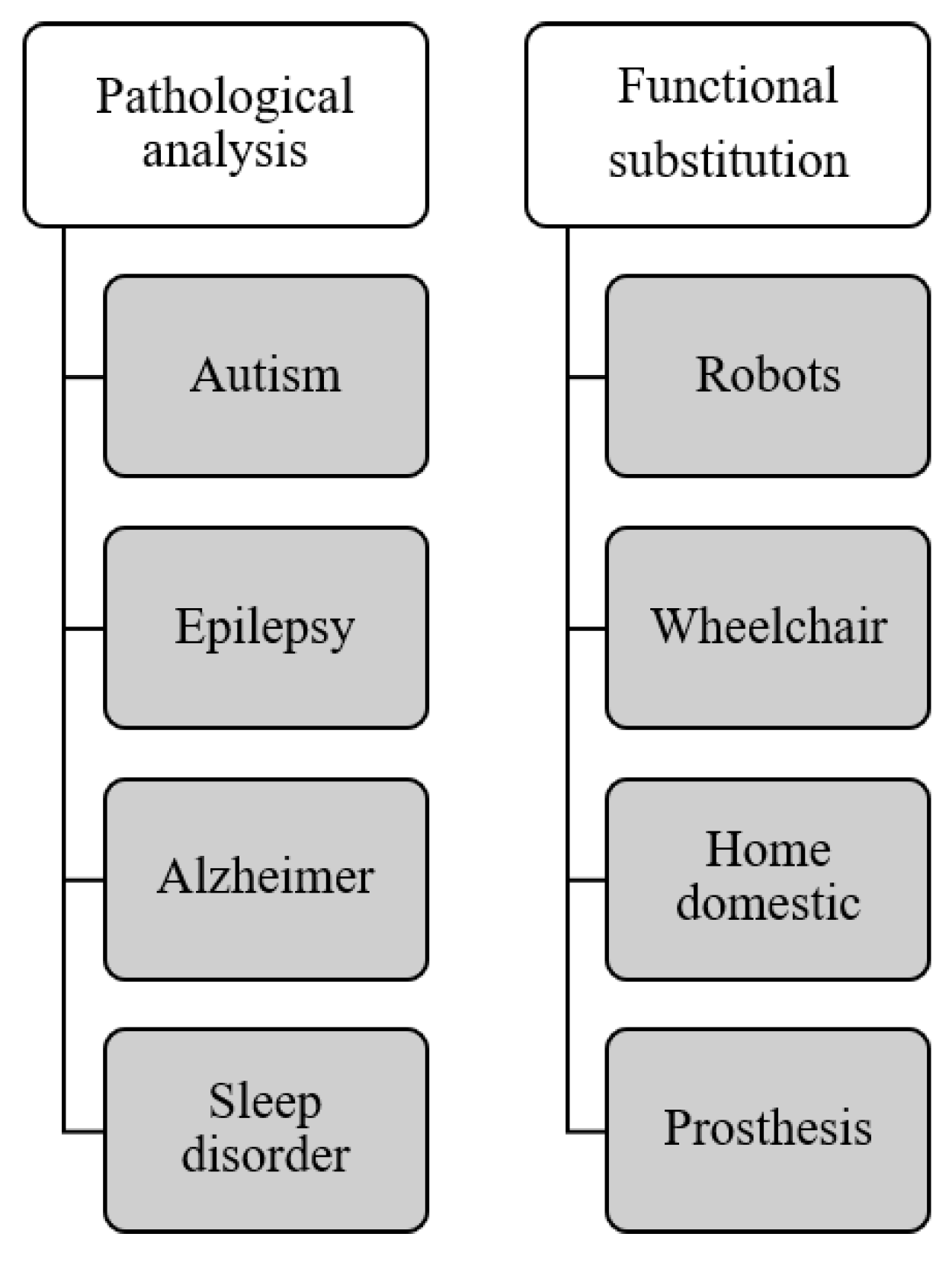
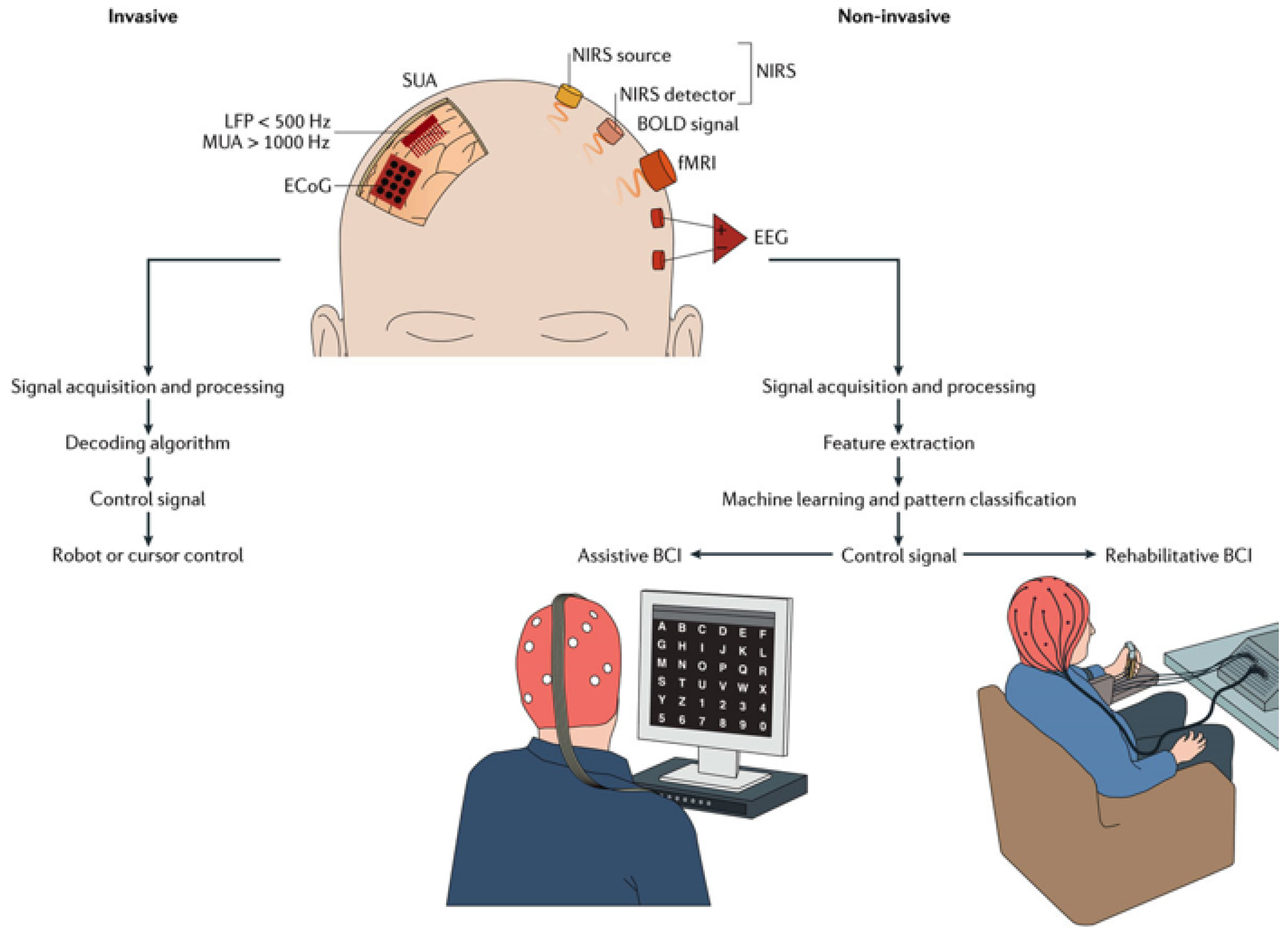
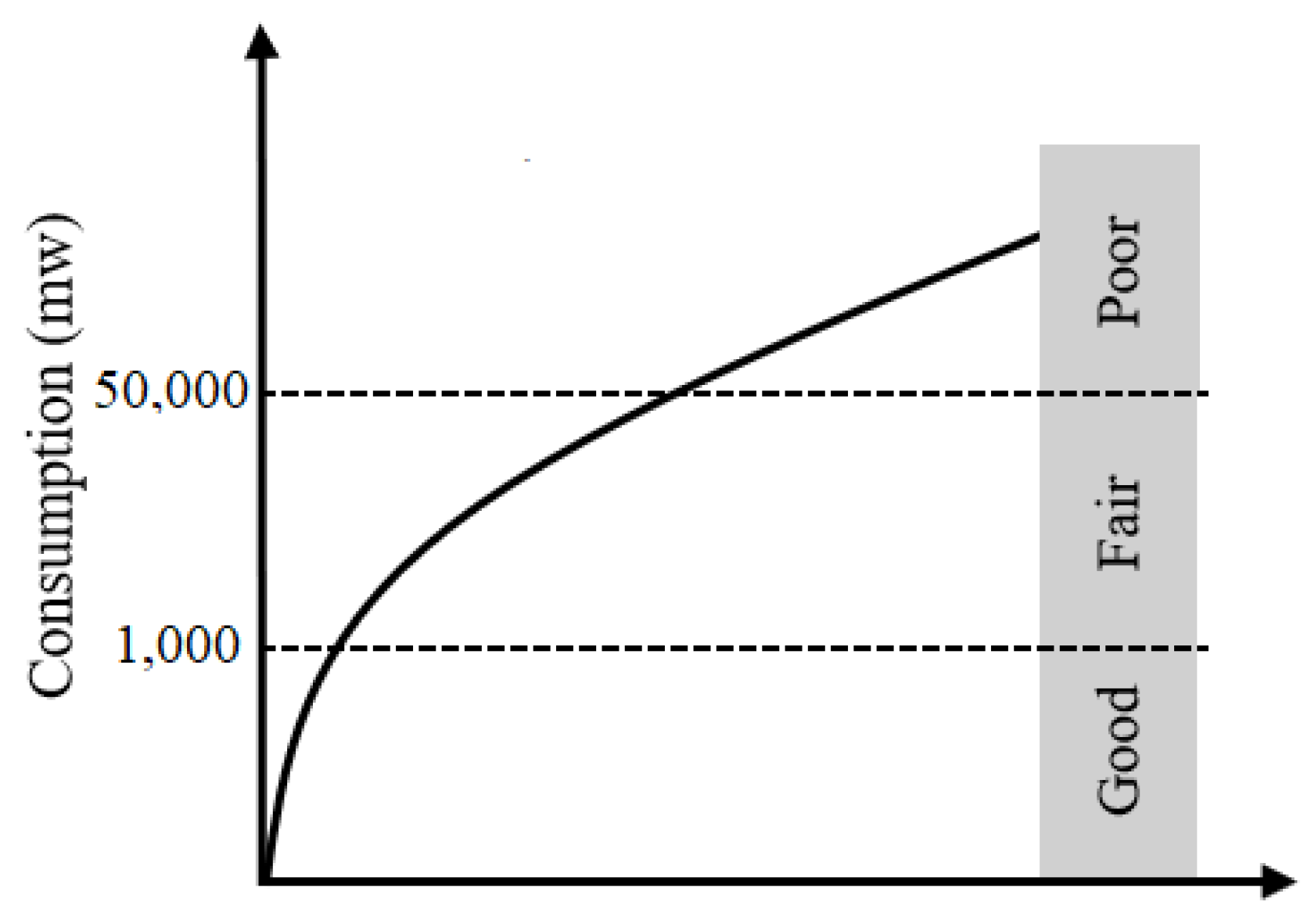
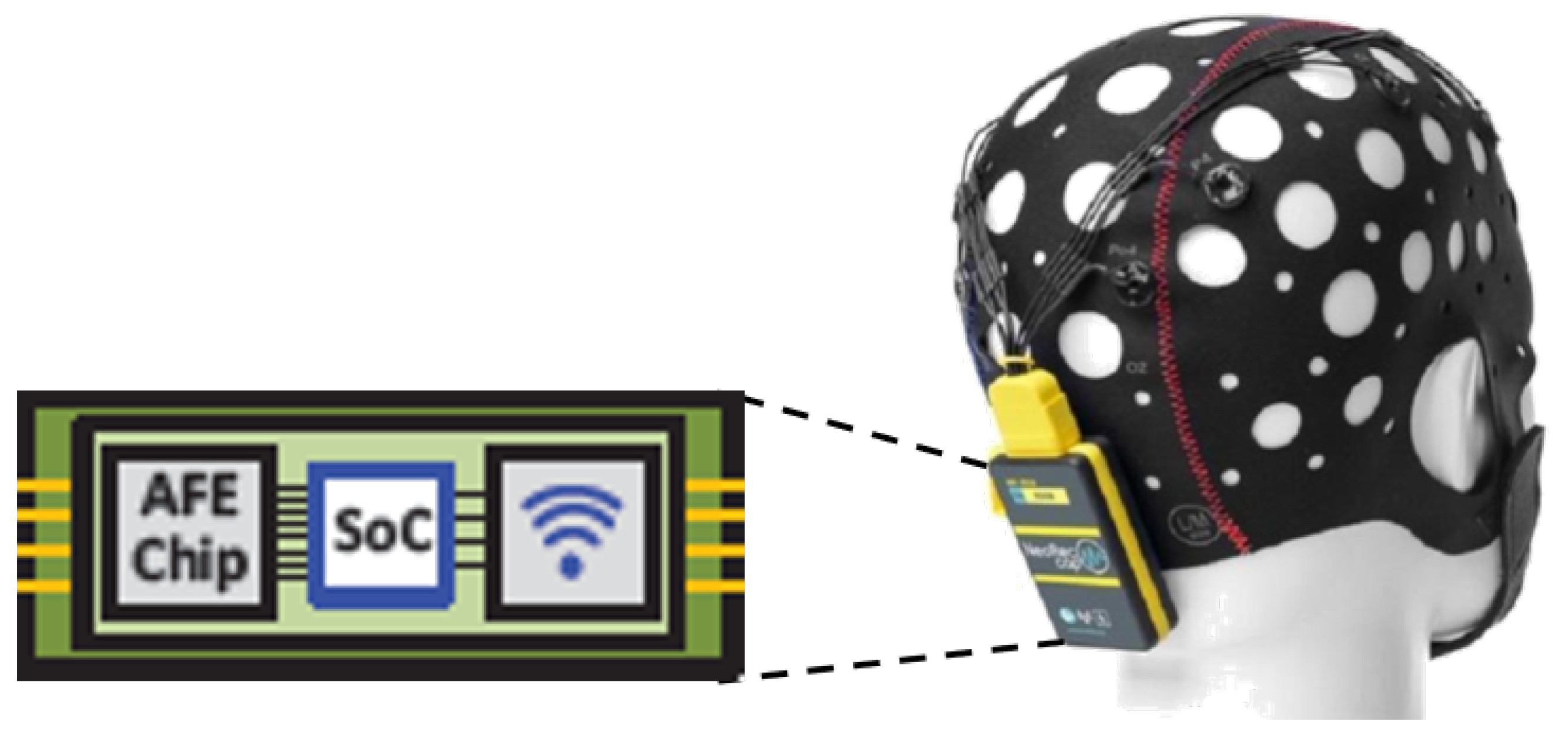
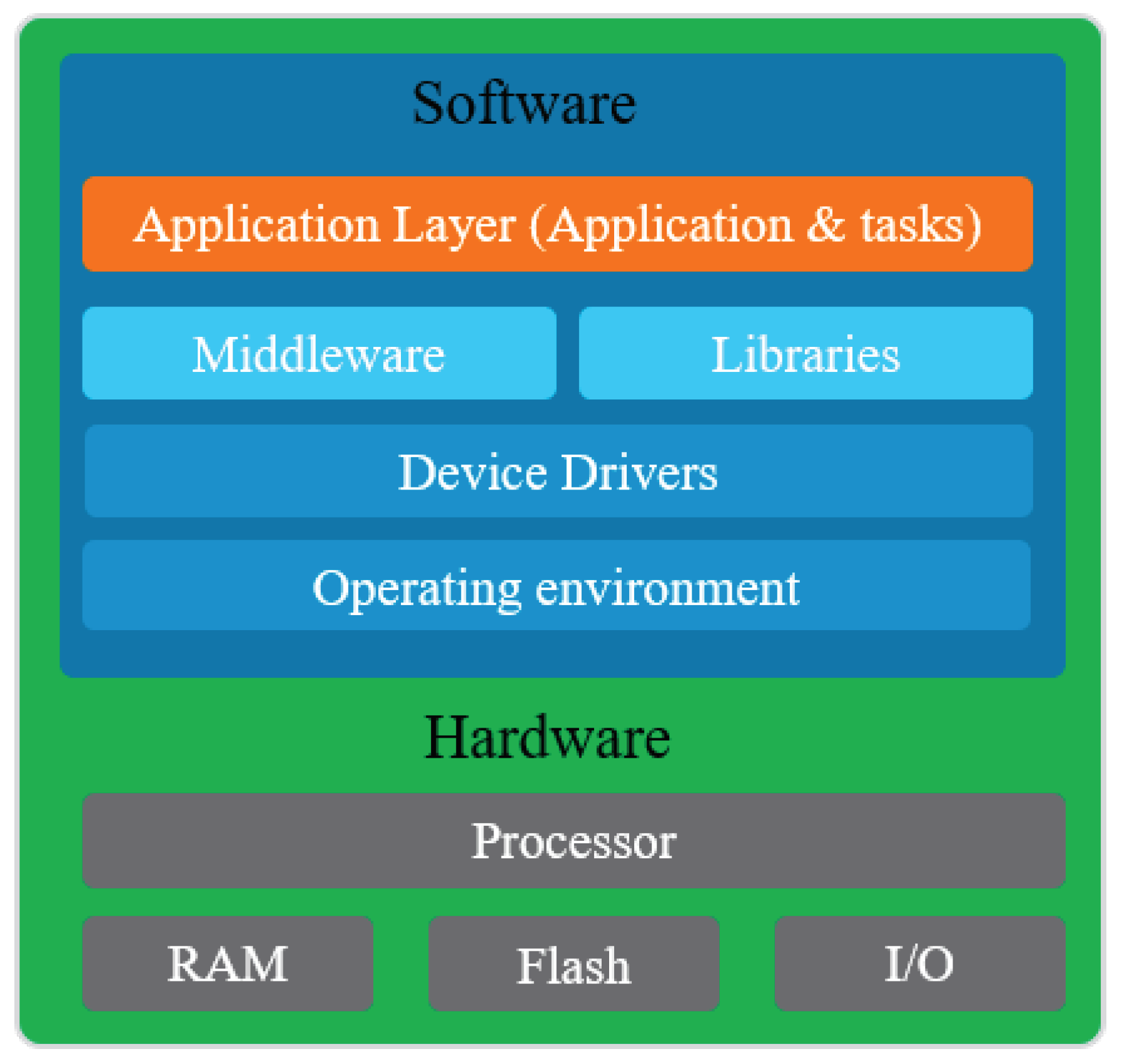
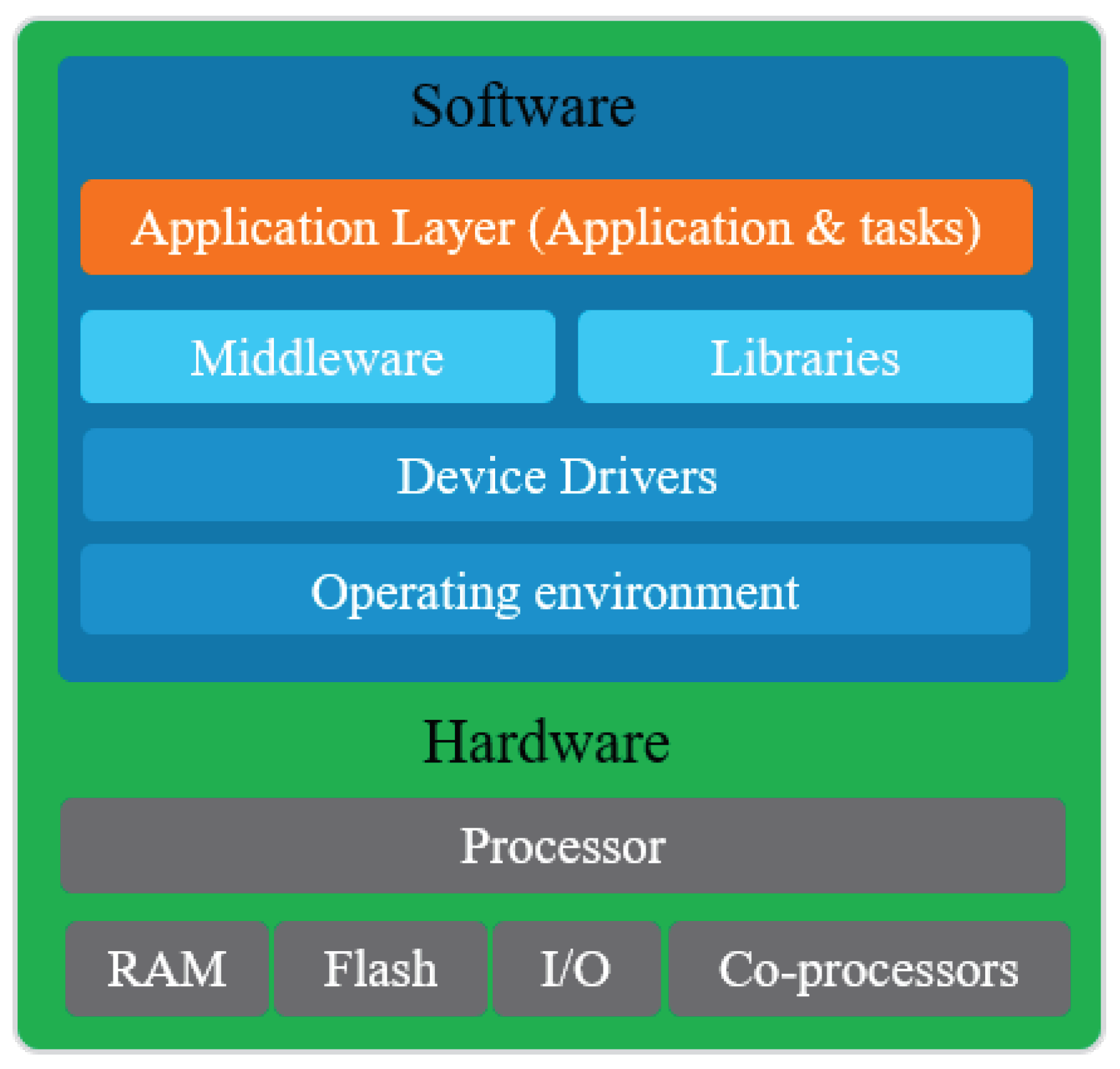
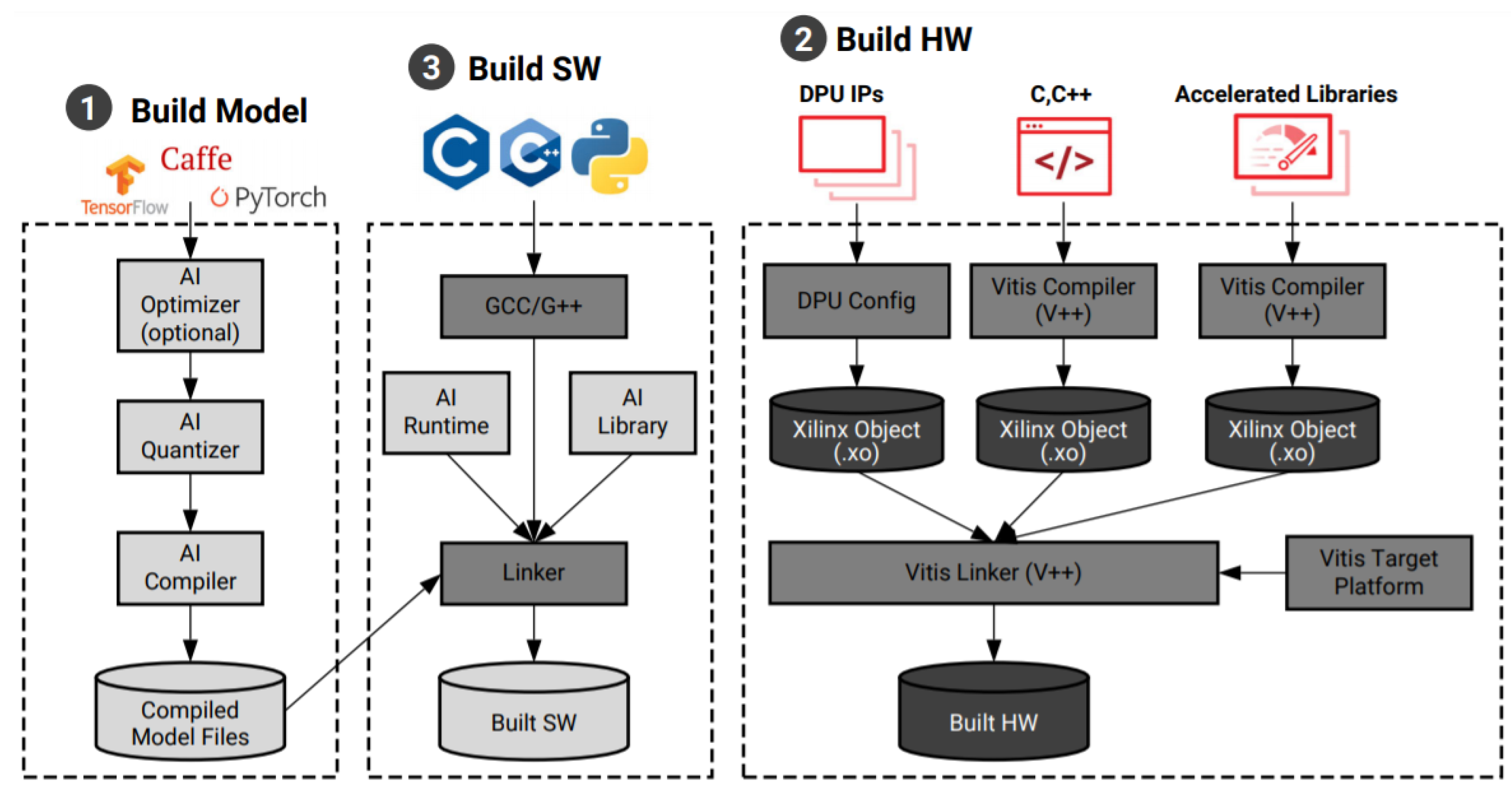
| Classification Accuracy | Accord |
|---|---|
| <50 | Poor |
| 50–75% | Fair |
| 75–100% | Good |
| Work | Year | Algorithms | Accuracy (%) | Platform | Time (ms) | Power (W) | Online/Offline | ||
|---|---|---|---|---|---|---|---|---|---|
| [40] | 2008 | 1 | 0 | Hamming window, STFT, PCA, Linear regression | 74.6 | DSP, ARM processor | 42 | ∼1 | Online |
| [22] | 2017 | 1 | 0 | PSD, ANN | 70 | Atmega128, AD8553 | 4000 | ∼0.9 | Online |
| [41] | 2017 | 1 | 0 | PSD, RMS, Threshold | 85 | ADS1298, STM32F407vgt6 | 0.7 | ∼0.091 | Online |
| [42] | 2018 | 1 | 0 | LP IIR, FFT, SVM | 96 | STM32F103CB, LMC6464, L3G4200D, | NA | 9 | Online |
| [43] | 2013 | 0 | 1 | N/I | N/I | Zarlink ZL70102, MSP430 | N/I | 2.2 | Online |
| [44] | 2014 | 1 | 1 | ICA, FFT, SVM | 91 | TI CC2564, FPGA, | N/I | 0.45 | Offline |
| [45] | 2010 | 1 | 1 | Bandpass filter, FFT, SVM | 93 | SoC | 6700 ± 3000 | 0.0002 | Online |
| [46] | 2018 | 0 | 0 | Long Short-Term Memory (LSTM) RNNs | N/I | Xilinx Zynq-7045 | 769 | N/I | Offline |
| [39] | 2018 | 1 | 1 | quadrature spline wavelet (QSW), PCA | N/I | FPGA cyclone II | 0.145 | 0.806 | Offline |
| [15] | 2014 | 1 | 0 | FIR, DWT, PSD, AR, Filter bank, Zero-crossing Histogram, Correlation, Phase synchronization, Mann–Whitney test, LSSVM | 96.93 | Spartan FPGA with a XC3S500E-PQ208 | 277.74 | N/I | Online |
| Work | Year | Algorithms | Accuracy (%) | Platform | Time (ms) | Power (W) | Online/ Offline | ||
|---|---|---|---|---|---|---|---|---|---|
| [13] | 2008 | 0 | 0 | Average filter, PCA, Linear regression | 74.6 | Virtex 6 | 2420 | 1.11 | Online |
| [49] | 2010 | 1 | 0 | FIR, DWT, SVM | N/I | Compact-RIO | N/I | 12.81 | Offline |
| [51] | 2015 | 1 | 0 | Theta spectra, threshold | 71 | FPGA Mobile tablet | N/I | 4 | Online |
| [52] | 2010 | 1 | 0 | STFFT, ICA, threshold | 78.24 | DSP | N/I | 1.11 | Online |
| [53] | 2017 | 0 | 0 | FFT, threshold | 99.4 | Micro2440SDK | ∼8500 | 24 | Online |
| [54] | 2013 | 1 | 0 | IIR, DWT, threshold hierarchical model | 91 | CompactDAQ | 2 | 12 | Online |
| [55] | 2016 | 0 | 1 | DWT, SVM | 82.1 | Odroid-xu4 | 0.11 | 20 | Offline |
| [56] | 2017 | 0 | 0 | Band-pass filter, average power, temporal correlation | 70 | Arduino Due MCU | 2.23 | 1 | Offline |
| [57] | 2014 | 0 | 0 | FFT, SLIC | 70 | Micro2440 (ARM) | 0.1 | 24 | Offline |
| [58] | 2017 | 0 | 1 | ERD/ERS, Adaptive Threshold | 75 | Zynq ZC7030 | 402 | 4.12 | Online, offline |
| [59] | 2014 | 0 | 1 | FFT, Mahalanobis distance | 82 | Blackfin, DSP | N/I | 4.02 | Online |
| [60] | 2014 | 0 | 0 | FFT | 98.8 | AT89S51, Tablet (AUSU) | 42 | 12 | Online |
| [48] | 2010 | 0 | 0 | Phase coding, FFT | 89.29 | Cyclone EP2C20Q FPG | 30.14 | ∼27 | Online |
| [61] | 2012 | 1 | 0 | FFT, Mardia test, Mahalanobis distance (MD) | 77.6 | Cyclone EP2C20Q FPG | 30.14 | ∼27 | Online |
| [14] | 2012 | 1 | 0 | Threshold | 61.6 | iPhone | 32 | ∼6 | Online |
| [62] | 2012 | 0 | 0 | FFT, Morlet Continuous Wavelet, Threshold | N/I | Spartan3 XC3S1400AN | 1 | N/I | Online |
| [63] | 2011 | 0 | 0 | PSD, LDA | 73.58 | ASIC, MSP430F1611, NRF24L | 200 | 0.001395 | Online |
| [23] | 2017 | 1 | 1 | Adaptive filter, CSP, MD | 94.47 | Stratix-IV | 394 | 1.067 | Offline |
| [64] | 2018 | 1 | 1 | WOLA filter bank, CSP, MD | 80.2 | Stratix-IV | 430 | 0.67 | Online, Offline |
| [65] | 2012 | 0 | 0 | Forward Filter, FLDA | 73.96 | Spartan 3E FPGA | N/I | N/I | Online |
| [66] | 2012 | 0 | 0 | FIR filterbank, Hidden Markov Models | 76.5 | Spartan 6 FPGA | N/I | N/I | Online |
| [67] | 2016 | 1 | 0 | adaptive filtering | N/I | FPGA Virtex-5 LX50T | N/I | N/I | Online |
| [68] | 2020 | 0 | 0 | PSD, band-pass filtering, canonical correlation analysis (CCA) | 80 | XC7K325T-2FFG900C | N/I | N/I | Online |
| [69] | 2017 | 0 | 0 | Median, FIR filter, FLDA | N/I | Virtex-5 | 0.01 | 0.67 | Online |
| [70] | 2015 | 0 | 0 | ICA, Canonical Correlation Analysis (CCA) | 86.5 | FPGA | 32000 | N/I | Online |
| [71] | 2016 | 0 | 0 | Blind Source Separation (BSS), CCA | 93.41 | FPGA | N/I | N/I | Online |
| [72] | 2018 | 0 | 0 | Sparse Bayesian Learning (BSBL), multi-layer perceptron regressor | 89.85 | Virtex7, ARM | N/I | N/I | Online |
| [47] | 2019 | 0 | 1 | CNN | 80.5 | Xilinx BNN-PYNQ | 1.97 | 0.025 | Offline |
| [73] | 2015 | 0 | 0 | FFT, Threshold | 88.88 | Xilinx & PC Tablet | 4430 | 70 | Online |
| [74] | 2018 | 1 | 0 | Surface Laplacian, Separable Common Spatio Spectral Pattern (SCSSP), Mutual Information (MI), Linear Discriminant Analysis (LDA), and Support Vector Machine (SVM) | 81.9 | Virtex-6 FPGA | 0.550 | 83 | Online & offline |
| [75] | 2020 | 0 | 0 | FIR filter, averaging method | 90.62 | Cyclone II EP2C35 DSP | ∼2000 | ∼27 | Online |
| [76] | 2019 | 1 | 0 | Channel selection, wavelet, energy normalization, LDA | 80 | Xilinx | 7.5 | 0.102 | Offline |
| [77] | 2013 | 0 | 0 | FFT, threshold | 92.5 | FPGA, MCP3201 microcontroller | 5200 | 1.74 | Online |
| [78] | 2020 | 0 | 0 | Canonical correlation analysis (CCA) | 76 | DE0-nano board | 0.00052 | ∼0.05 | Online |
| [79] | 2019 | 0 | 0 | CCA | 87.89 | Cyclone IV EP4CE115 | 1500 | ∼0.05 | Offline |
| [80] | 2020 | 0 | 0 | Long Short-Term Memory (LSTM) | 87.89 | MindReading photonic ULQ | 1500 | 0.2155 | Offline |
| [81] | 2019 | 0 | 0 | bandpass Butterworth filter, DWT, Feedforward Neural Network (FFNN) | 96.09 | Raspberry Pi 3B | N/I | 5.77 | Online |
| Parameter | Value | Reason |
|---|---|---|
| Computed according to the equation (Equation (1)). | The ITR takes into consideration the system accuracy and the timing, which represent two criteria from the predefined criteria and are important to evaluate the EBCI systems. | |
| =1/3, if the EBCI system is controlled by the evoked potential signals. | The EBCI system is more comfortable when it is controlled by SP. Thus, we are given the highest weight for the EBCI system controlled by SP. | |
| =2/3, if the EBCI system controlled by the spontaneous signals (SP). | ||
| =1/3, if the EBCI system is static (same parameters for all subjects). | The EBCI system is more accurate when the EBCI parameters are defined for each subject. Thus, the highest weight is given for the EBCI system toke in consideration the inter-subject variability. | |
| =2/3, if the EBCI is adaptive. | ||
| =1/3, if the EBCI system is checked and validated according to the offline approach only. | The accuracy of the EBCI system is validated according to the online approach and is more reliable which reflects the usefulness of the EBCI system. | |
| =2/3, if the EBCI system is checked and validated according to the online approach. | ||
| The measured power of the EBCI system. | One of the important criteria to evaluate the EBCI systems. | |
| Number of channels that is used during the recording of the brain signals. | The number of channels differ from one system to another and has an effect on the runtime and the power consumption. For this reason, it should be taken into consideration during the comparison between EBCIs. |
Publisher’s Note: MDPI stays neutral with regard to jurisdictional claims in published maps and institutional affiliations. |
© 2021 by the authors. Licensee MDPI, Basel, Switzerland. This article is an open access article distributed under the terms and conditions of the Creative Commons Attribution (CC BY) license (https://creativecommons.org/licenses/by/4.0/).
Share and Cite
Belwafi, K.; Gannouni, S.; Aboalsamh, H. Embedded Brain Computer Interface: State-of-the-Art in Research. Sensors 2021, 21, 4293. https://doi.org/10.3390/s21134293
Belwafi K, Gannouni S, Aboalsamh H. Embedded Brain Computer Interface: State-of-the-Art in Research. Sensors. 2021; 21(13):4293. https://doi.org/10.3390/s21134293
Chicago/Turabian StyleBelwafi, Kais, Sofien Gannouni, and Hatim Aboalsamh. 2021. "Embedded Brain Computer Interface: State-of-the-Art in Research" Sensors 21, no. 13: 4293. https://doi.org/10.3390/s21134293
APA StyleBelwafi, K., Gannouni, S., & Aboalsamh, H. (2021). Embedded Brain Computer Interface: State-of-the-Art in Research. Sensors, 21(13), 4293. https://doi.org/10.3390/s21134293







